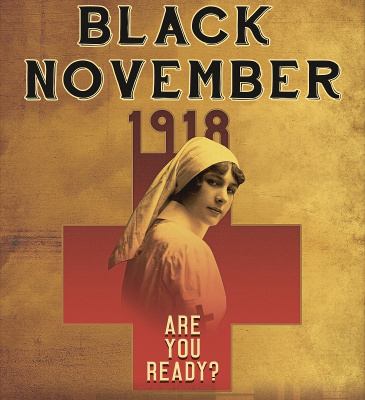BLACK NOVEMBER 1918
Meet at 83 Fairlie Terrace, Kelburn (VUW), Wellington
09/10/2018 - 17/10/2018
Production Details
On the 100 year anniversary of the 1918 influenza pandemic that plagued New Zealand, THEA 301 presents Black November 1918. Following the end of World War One and in the wake of celebrating our soldiers return – New Zealand was confronted with the most lethal disease outbreak we have ever seen, an estimated 9000 New Zealanders died in two months.
Black November 1918 is a promenade-style devised performance and it delves into the homes and lives of ordinary Wellingtonians affected by the flu. It confronts the audience with the potential impact a modern day flu pandemic would have on 2018 New Zealand.
Interested parties can learn more about the show by visiting pandemic1918.co.nz
Audiences will meet at the box office at 83 Fairlie Tce at 7.15pm and they will move through multiple spaces. Please advise if you need wheelchair access.
83 Fairlie Terrace, Kelburn (Gate 10 of Victoria University)
9th to the 17th of October 2018
7.15pm arrival for a 7.30pm show
(no show on Sunday)
Tickets (Waged $16 | Unwaged $8) are available through eventfinda.co.nz
Bookings: Email theatre@vuw.ac.nz
Theatre , Promenade ,
Confused dramaturgy and problematic dramatic structure
Review by Brett Adam 10th Oct 2018
Let me begin by acknowledging my difficulty in pinning down the appropriate context in which to review this piece. Performed by students of Victoria University of Wellington’s theatre programme, Black November is not a professional production, nor is it a production by a professional actor training institution, therefore I cannot in good conscience hold these committed young performers to these standards. I also have no clear idea about the intentions of this production. Perhaps a brief programme note about the THEA course and what this work is trying to achieve academically in would have helped here.
Having said this Black November is a mostly entertaining if somewhat dramaturgically confused piece. The publicity promises a promenade production but this is only partly true. The work is divided into two distinct parts. This first is indeed promenade: after being invited to a celebration of returning soldiers from the first world war, the festivities are interrupted by an (unconvincing yet fun) intrusion of modern day characters in hazchem suits who usher us all, audience and actors (who have dropped their characters and now ‘play’ themselves), into the main theatre building, where we are moved up and down stairwells, through cramped hallways, and into various rooms and spaces.
Here we learn about the 1918 influenza pandemic and the possible affects a contemporary outbreak might have on society. The trouble with this section is that it is based on the assumption that the audience ‘believes’ the scenario, that we really are being quarantined against our will and that various people are showing signs of sickness and are being taken: escorted somewhere, or worse. This half of the piece would greatly benefit from a less naturalistic playing style. Rather than trying to convince us that that they are doctors or government officials, it may be more successful if the actors were less serious about the piece and actually acknowledged the theatrical pretence of the situation and the humour that this allows.
The second half of the work is less successful. We are ushered into our “final holding area” which is revealed to be the main theatre space. Taking our seats in the gallery we then watch a traditional naturalistic play. My main problem with this part of Black November is that in the opening section the actors have dropped all pretence to character and interacted with us as themselves yet now they reassume these dramatic personae with no acknowledgment of this initial rupture. This makes the engaging opening premise of the work somewhat redundant and confusing.
The writing here also suffers from trying to cover too much: the effects of the 1918 flu pandemic on society, post traumatic shock syndrome, health professionals’ guilt at not being able to save more people (leading to an unjustified and unconvincing descent into madness), excessive and draconian governmental measures to halt the infection: the march into the inhalation chamber is (unintentionally?) shocking, bringing to mind similar marches forced upon Jews, homosexuals, gypsies and other ‘undesirables’ during the second world war, and racism to name a few.
The beautiful minimalist design (Mark Nicholas mentored by Luscas Neal) here is one of the stand-out elements of the production, allowing for quick changes in location and providing the opportunity for interesting theatrical realisation of various dreamscapes and nightmares. I must also make mention of two performers: Oliver Pol, whose playful presentation of his character in the first section acknowledges and revels in its inherent humour and cheesiness, and Emma Rattenbury, whose strong emotional embodiment of her character (despite playing a woman twice her age) comes the closest to the level of work this section is aiming for.
Overall director Kerryn Palmer has done a good job of marshalling the talents of a disparate group of theatre students, but is let down by a confused dramaturgy and problematic dramatic structure.
Copyright © in the review belongs to the reviewer






Comments